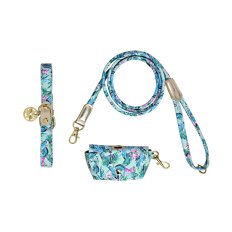By: BeChewy.com
Taking a pet for a nice, long walk is an experience unique to those who share their lives with a dog. It may even be part of the reason you became a pup parent to begin with—your love of fresh air and appreciation for the advantages of building a little exercise into your day. The walking routine is important for your pet as well, not only for the primary purpose of doing his business, but to get exercise himself. What may come as a surprise is that your dog may not naturally take to behaving well on a leash. In fact, it may be difficult enough that you’re soon wondering how to leash train a dog (or, how to leash train a puppy, as the case may be).
Before you begin leash training, though, keep in mind that leashes are management tools. “They should be used to protect dogs from danger or running off somewhere they shouldn’t be, and not to be yanked or manipulated,” says Joan Hunter Mayer, certified professional dog trainer and owner of the Inquisitive Canine in Santa Barbara, CA.
Make sure to use a dog leash that’s durable and properly sized. The Frisco solid nylon dog leash is one option where functionality meets style. This leash is available in four different color options and uses an Ulta-Weld™ seal designed for strength and comfort for your pup.
Here are simple tips that will help make leash training easier, so both of you can enjoy many walks together.
First, determine what you’re trying to teach. If you’re not focused on what you want your dog to learn, you won’t be an effective teacher. Assess your dog’s baseline of behaviors—what he already knows how to do—then go from there. According to Mayer, dogs should know: “Watch me” (making eye contact with you); sit and/or stay; leaving things alone when asked; greeting people and other dogs; and adjusting their pace (running, walking and standing still).
Start with a few dry runs. Have a couple of “dress rehearsals” at a time of day when distractions (cars, other dog walkers, school buses and kids) are at a minimum. Dress your dog in his walking gear, and set out, keeping him next to you. You’ll want to teach him to walk on both sides—but only one per session.
A few words on how to leash train a puppy. If you’re working on puppy leash training, practice in a backyard, on a deck or even inside. The big wide world, even at relatively quiet times, can be overwhelming to the wee ones. And go into the process knowing that puppy leash training is often a slower process than it is with an adult dog. If you find yourself frustrated, that may be your cue that it’s just too soon. Wait a few weeks and try again.
Reward the right way. Reward him with lots of praise and petting (and maybe even a treat!) for walking next to you, suggests Mayer. Just remember to do it when your dog is in the specific position you want him to be in. “If you stop, and he swings out in front and sits down, coax him to your side and reward him there—unless you’ve asked him to sit, of course,” advises Mayer.
You can also try using “breaks” as rewards. For instance, if (or, more likely, when!) he wants to sniff around, “Ask for a sit or eye contact first, then let him sniff and ‘be free’ for a bit, before walking nicely again,” advises Mayer.
Ease up on the leash pressure. “Ideally, there should always be a nice bend in a dog leash,” notes Annie Grossman, CPDT-KA and owner of School For The Dogs, a dog training center in New York City’s East Village. “Relaxing leash pressure will also take some strain from your arm and shoulders, and help relieve the pressure on your dog’s neck.” Grossman also points out that being yanked back every time your dog approaches a person or another dog can ultimately lead to fear of other dogs, or even being outside in general.
Step lively. Walking at a fast pace can put you at an advantage. If your dog is focusing on keeping up with you, he is going to have a harder time pulling ahead, explains Grossman. Periodic changes in direction can also help make sure he always has at least some of his focus on you.
Practice, practice, practice. Even after you’re sure you’ve totally figured out how to leash train a dog, your pet can forget what you’ve taught him. At those times, the importance of reinforcing positive behavior can hardly be overstated, says Mayer. Mayer suggests playing the red-light, green-light game. “If he pulls, stop walking,” says Mayer. “The pulling of the leash turns the light red. Once there is slack again, the light turns green, and you continue walking.” With consistency, your dog will understand what the better choice is.
Look at the harness. If pulling continues to be an issue throughout your leash training, you might consider a chest-clip harness. When a leash is attached at a dog’s neck or back, they have more weight with which to pull than they do if it is connected at the chest. The PetSafe Easy Walk Dog Harness is designed to redirect forward motion. The belly strap is a complementary color, so it’s easy to see which strap goes over the shoulders and which goes under the belly.
Finally, recognize the difference between greeting and playing. Sure, you want your fur baby to make friends, but “dogs on leashes shouldn’t be playing with each other in the street. Leash time isn’t social time,” reminds Grossman. Keep greetings short and sweet—3 seconds or so. Of course, you should ask the other dog’s mom or dad if it’s okay to say hello first. If the two see each other on walks fairly regularly and seem to hit it off, you can always arrange a puppy playdate, when the pals can romp off their leashes.

